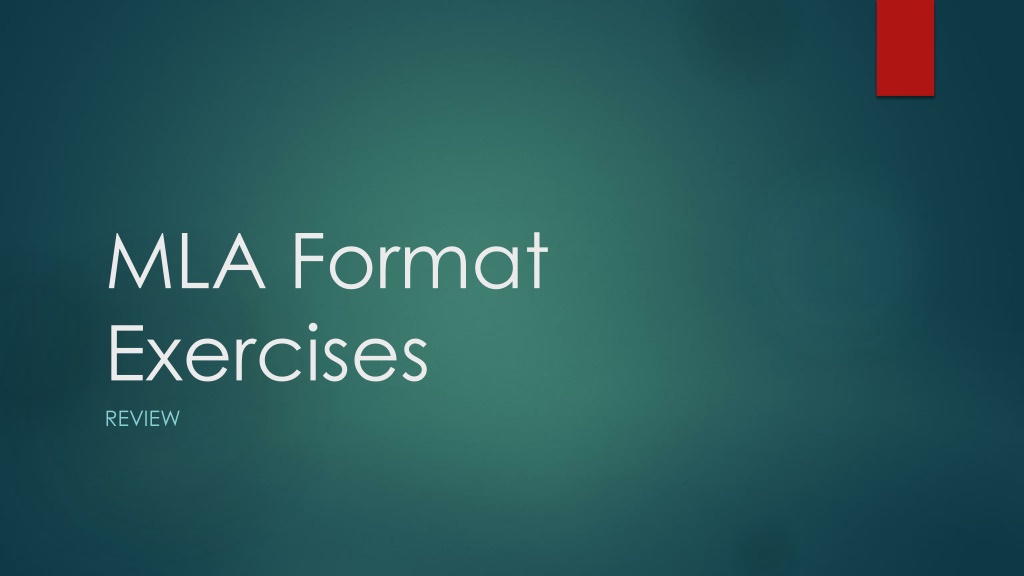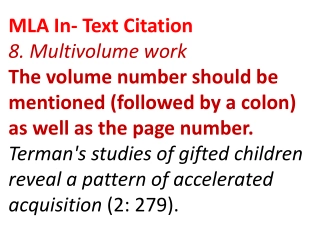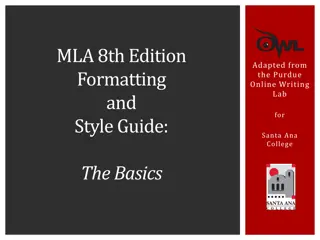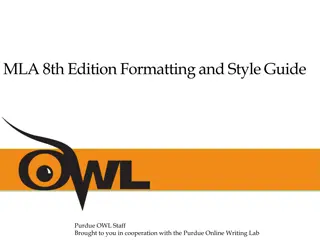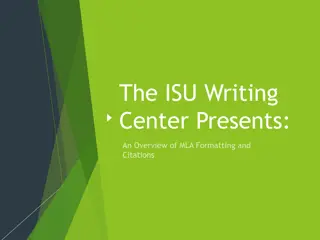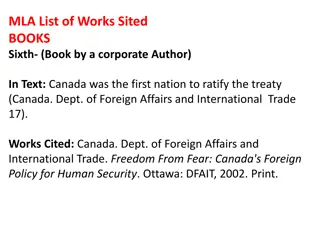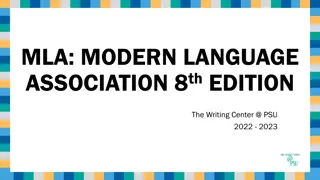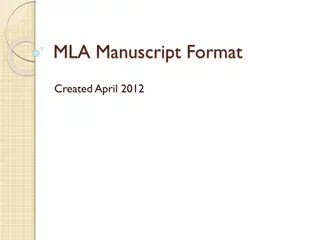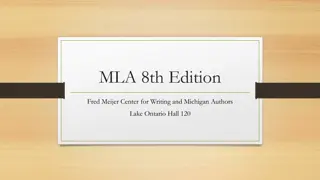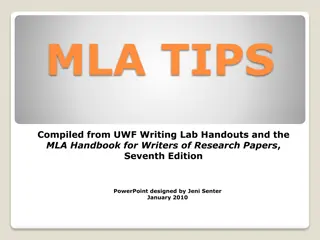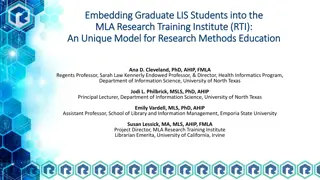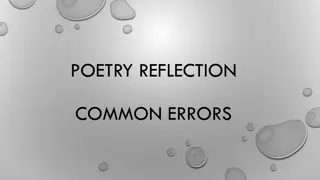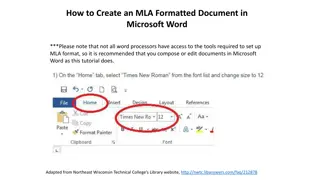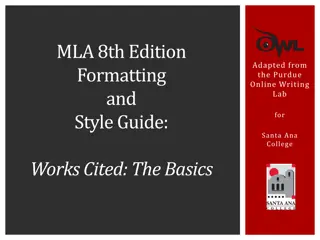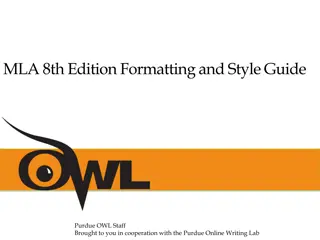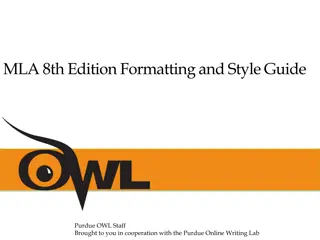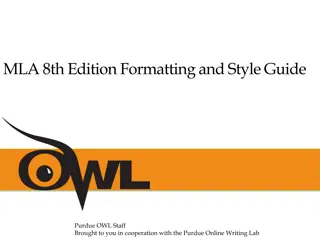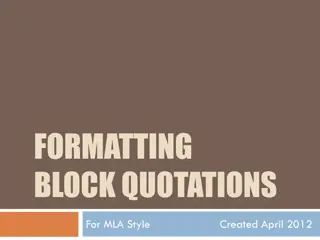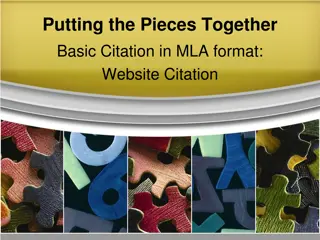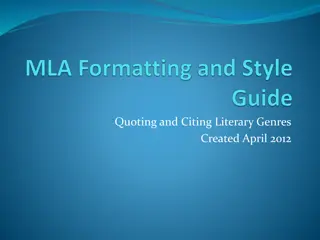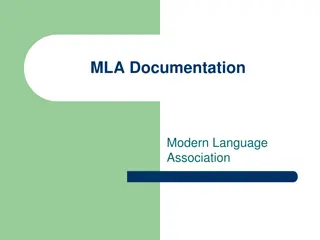MLA Format Exercises Review
This document provides exercises on in-text citations, works cited entries, quoting, the use of brackets, slashes, and ellipsis in MLA format. It includes examples and practice exercises for each component to help improve understanding and application of MLA citation rules.
Download Presentation

Please find below an Image/Link to download the presentation.
The content on the website is provided AS IS for your information and personal use only. It may not be sold, licensed, or shared on other websites without obtaining consent from the author. Download presentation by click this link. If you encounter any issues during the download, it is possible that the publisher has removed the file from their server.
E N D
Presentation Transcript
MLA Format Exercises REVIEW
PART I- In-text Citation Exercise ( Impact of Global Warming 6) (Stein et al. 25) (Nazarene and Moses 189) (Insiders and Outsiders; American Debutante) A. (3), B. (Burke 3)
PART II- Works Cited Exercise Jung, Wolfgang and Nathan Nelson. Nature s Rotary Electromotors. Science. 29 April 2005, pp. 642-44. Science Online. 2009. FULL URL. Accessed 5 March Henley, Patricia. The Hummingbird House. MacMurray, 1999. Burns, Robert. Red, Red Rose. 100 Best-Loved Poems. Ed. Philip Smith. Dover, 1995. Aging: Women Expect to Care for Aging Parents but Seldom Prepare. Women s Health Weekly. 20 May 2007. pp. 26 Wysocki, Anne Frances et al. Writing New Media: Theory and Applications for Expanding the Teaching of Composition. Utah State UP, 2004.
PART III: Quoting Exercise In Arby by James Joyce, the boy reveals his epiphany at the end: I saw myself as a creature driven and derided by vanity; and my eyes burned with anguish and anger (5). According to Sammy in A&P by John Updike, That s all right, Lengel said. But this isn t the beach when Queenie tells him that she only came to pick-up a jar of herring snack for her mother (37). Edwin Arlington Robinson demonstrates irony when he writes, And Richard Cory, one calm summary night/Went home and put a bullet in his head (15-6).
PART VI: Brackets Exercise (For more details on brackets, see The Chicago Manuel of Style [2003].) He has difficulty correctly pronouncing nuclear [noo-klee-er]. The instructions read, Be sure to tighten it s [sic] lid securely. She said, My [marketing] proposal was approved by the committee. Civil War Historian Jacob Maxwell writes, He [Abraham Lincoln] issued the Emancipation Proclamation in 1863 and promoted the passage of the Thirteenth Amendment to the United States Constitution, abolishing slavery, and as the Sixteenth President of the United States, his most famous speech was the Gettysburg Address.
PART VII: Slash Exercise Let the learned say what they can, / Tis ready money makes the man. These lines of poetry by the Englishman William Somerville (1645- 1742) may apply to a current American economic problem. The hermit of Robert Bly s poems of he same name is a man whose body is perfectly whole. / He stands, the storm behind him, / And the grass blades are leaving in the wind. / Darkness is gathered in folds. / About his feet. He is no one. W. B. Yeats wrote, When you are old and grey and full of sleep / And nodding by the fire, take down this book / And slowly read of the soft look / Your eyes had once, and of their shadows deep.
PART VIII: Ellipsis You not only must understand your audience but also keep this audience in mind at all times as you draft your paper and adapt your writing to that audience (Leibensperger 2). that individual styles must be assessed and if a learner is going to have the best opportunity to learn, instructional techniques must be used that are congruent with the student s style (DeBello 205). The thought police would get him just the same. He had committed the essential crime that contained all others in itself. Thought-crime, the called it (Orwell 19). I wish I could explain this place to you everywhere is green and a great mountain juts out against the sky, beckoning (Jones 3).
